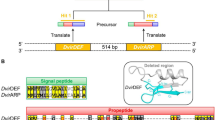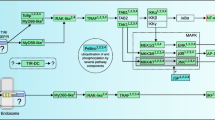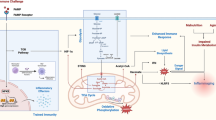Summary
The elimination of infectious non-self by the host defense systems of multicellular organisms requires a variety of recognition and effector molecules. The diversity is generated in somatic cells or encoded in the germ-line. In adaptive immunity in jawed vertebrates, the diversity of immunoglobulins and antigen receptors is generated by gene rearrangements in somatic cells. In innate immunity, various effector molecules and pattern recognition receptors, such as antimicrobial peptides and peptidoglycan recognition proteins, are encoded in the germ-line of multicellular organisms, including insects and jawed vertebrates. In the present review, we discuss how insect host defense systems recognize and eliminate a multitude of microbes via germ-line-encoded molecules, including recent findings that a Drosophila member of the immunoglobulin superfamily is extensively diversified by alternative splicing in somatic immune cells and participates in the elimination of bacteria.
Similar content being viewed by others
Abbreviations
- DAP:
-
diaminopimelic acid
- Dscam:
-
Down syndrome cell adhesion molecule
- GNBP:
-
Gram-negative binding protein
- IKK:
-
IκB kinase
- Ig:
-
immunoglobulin
- GlcNAc:
-
N-acetylglucosamine
- MurNAc:
-
N-acetylmuramic acid
- NF-κB:
-
nuclear factor κB
- PGRP:
-
peptidoglycan recognition protein
- PPAE:
-
proPO activating enzyme
- proPO:
-
prophenoloxidase
- TLR:
-
Toll-like receptor
- TNF:
-
tumor necrosis factor
References
Janeway, C.A. Jr., How the immune system works to protect the host from infection: a personal view, Proc. Natl. Acad. Sci. USA, 98 (2001) 7461–7468.
Hoffmann, J.A. and Reichhart, J.M., Drosophila innate immunity: an evolutionary perspective, Nat. Immunol., 3 (2002) 121–126.
Ferrandon, D., Jung A.C., Criqui, M., Lemaitre, B., Uttenweiler-Joseph, S., Michaut, L., Reichhart, J. and Hoffmann, J.A., A drosomycin-GFP reporter transgene reveals a local immune response in Drosophila that is not dependent on the Toll pathway, EMBO J., 17 (1998) 1217–1227.
Hoffmann, J.A., The immune response of Drosophila, Nature, 426 (2003) 33–38.
Hultmark, D., Drosophila immunity: paths and patterns, Curr. Opin. Immunol., 15 (2003) 12–19.
Steiner, H., Hultmark, D., Engstrom, A., Bennich, H. and Boman, H.G., Sequence and specificity of two antibacterial proteins involved in insect immunity, Nature, 292 (1981) 246–248.
Bulet, P., Stocklin, R. and Menin, L., Anti-microbial peptides: from invertebrates to vertebrates, Immunol Rev., 198 (2004) 169–184.
Natori, S., Bacteriocidal substance induced in the hemolymph of Sarcophaga peregrina larvae, J. Insect Physiol., 23 (1977) 1169–1173.
Okada, M. and Natori, S., Purification and characterization of an antibacterial protein from haemolymph of Sarcophaga peregrina (flesh-fly) larvae, Biochem. J., 211 (1983) 727–734.
Ando, K., Okada, M. and Natori, S., Purification of sarcotoxin II, antibacterial proteins of Sarcophaga peregrina (flesh fly) larvae, Biochemistry, 26 (1987) 226–230.
Baba, K., Okada, M., Kawano, T., Komano, H. and Natori, S., Purification of sarcotoxin III, a new antibacterial protein of Sarcophaga peregrina, J. Biochem. (Tokyo)., 102 (1987) 69–74.
Matsuyama, K. and Natori, S., Purification of three antibacterial proteins from the culture medium of NIH-Sape-4, an embryonic cell line of Sarcophaga peregrina, J. Biol. Chem., 263 (1988) 17112–17116.
Iijima, R., Kurata, S. and Natori, S., Purification, characterization, and cDNA cloning of an antifungal protein from the hemolymph of Sarcophaga peregrina (flesh fly) larvae, J. Biol. Chem., 268 (1993) 12055–12061.
Okada, M. and Natori, S., Mode of action of a bactericidal protein induced in the haemolymph of Sarcophaga peregrina (flesh-fly) larvae, Biochem. J., 222 (1984) 119–124.
Kanai, A. and Natori, S., Cloning of gene cluster for sarcotoxin I, antibacterial proteins of Sarcophaga peregrina, FEBS Lett., 258 (1989) 199–202.
Iwai, H., Nakajima, Y., Natori, S., Arata, Y. and Shimada, I., Solution conformation of an antibacterial peptide, sarcotoxin IA, as determined by 1H-NMR, Eur. J. Biochem., 217 (1993) 639–644.
Nakajima, Y., Qu, X.M. and Natori, S., Interaction between liposomes and sarcotoxin IA, a potent antibacterial protein of Sarcophaga peregrina (flesh fly), J. Biol. Chem., 262 (1987) 1665–1669.
Ando, K. and Natori, S., Inhibitory effect of sarcotoxin IIA, an antibacterial protein of Sarcophaga peregrina, on growth of Escherichia coli, J. Biochem. (Tokyo)., 103 (1988) 735–739.
Matsuyama, K. and Natori, S., Mode of action of sapecin, a novel antibacterial protein of Sarcophaga peregrina (flesh fly), J. Biochem. (Tokyo)., 108 (1990) 128–132.
Matsuyama, K. and Natori, S., Molecular cloning of cDNA for sapecin and unique expression of the sapecin gene during the development of Sarcophaga peregrina, J. Biol. Chem., 263 (1988) 17117–17121.
Komano, H., Homma, K. and Natori, S., Involvement of sapecin in embryonic cell proliferation of Sarcophaga peregrina (flesh fly), FEBS Lett., 289 (1991) 167–170.
Silverman, N. and Maniatis, T., NF-kappaB signaling pathways in mammalian and insect innate immunity, Genes Dev., 15 (2001) 2321–2342.
Georgel, P., Naitza, S., Kappler, C., Ferrandon, D., Zachary, D., Swimmer, C., Kopczynski, C., Duyk, G., Reichhart, J.M. and Hoffmann, J.A., Drosophila immune deficiency (IMD) is a death domain protein that activates antibacterial defense and can promote apoptosis, Dev. Cell, 1 (2001) 503–514.
Vidal, S., Khush, R.S., Leulier, F., Tzou, P., Nakamura, M. and Lemaitre, B., Mutations in the Drosophila dTAK1 gene reveal a conserved function for MAPKKKs in the control of rel/NF-kappaB-dependent innate immune responses, Genes Dev., 15 (2001) 1900–1912.
Silverman, N., Zhou, R., Stoven, S., Pandey, N., Hultmark, D. and Maniatis, T., A Drosophila IkappaB kinase complex required for Relish cleavage and antibacterial immunity, Genes Dev., 14 (2000) 2461–2471.
Rutschmann, S., Jung, A.C., Zhou, R., Silverman, N., Hoffmann, J.A. and Ferrandon, D., Role of Drosophila IKK gamma in a toll-independent antibacterial immune response, Nat. Immunol., 1 (2000) 342–347.
Leulier, F., Rodriguez, A., Khush, R.S., Abrams, J.M. and Lemaitre, B., The Drosophila caspase Dredd is required to resist gram-negative bacterial infection, EMBO Rep., 1 (2000) 353–358.
Stoven, S., Ando, I., Kadalayil, L., Engstrom, Y. and Hultmark, D., Activation of the Drosophila NF-kappaB factor Relish by rapid endoproteolytic cleavage, EMBO Rep., 1 (2000) 347–352.
Hedengren, M., Asling, B., Dushay, M.S., Ando, I., Ekengren, S., Wihlborg, M. and Hultmark, D., Relish, a central factor in the control of humoral but not cellular immunity in Drosophila, Mol. Cell, 4 (1999) 827–837.
Lemaitre, B., Nicolas, E., Michaut, L., Reichhart, J.M. and Hoffmann, J.A., The dorsoventral regulatory gene cassette spatzle/Toll/cactus controls the potent antifungal response in Drosophila adults, Cell, 86 (1996) 973–983.
Tauszig-Delamasure, S., Bilak, H., Capovilla, M., Hoffmann, J.A. and Imler, J.L., Drosophila MyD88 is required for the response to fungal and Gram-positive bacterial infections, Nat. Immunol., 3 (2002) 91–97.
Ip, Y.T., Reach, M., Engstrom, Y., Kadalayil, L., Cai, H., Gonzalez-Crespo, S., Tatei, K. and Levine M., Dif, a dorsal-related gene that mediates an immune response in Drosophila, Cell, 75 (1993) 753–763.
Wu, L.P. and Anderson, K.V., Regulated nuclear import of Rel proteins in the Drosophila immune response, Nature, 392 (1998) 93–97.
Lemaitre, B., Reichhart, J.M. and Hoffmann, J.A., Drosophila host defense: differential induction of antimicrobial peptide genes after infection by various classes of microorganisms, Proc. Natl. Acad. Sci. USA, 94 (1997) 14614–14619.
Akira, S., Takeda, K. and Kaisho, T., Toll-like receptors: critical proteins linking innate and acquired immunity, Nat. Immunol., 2 (2001) 675–680.
Weber, A.N., Tauszig-Delamasure, S., Hoffmann, J.A., Lelievre, E., Gascan, H., Ray, K.P., Morse, M.A., Imler, J.L. and Gay, N.J., Binding of the Drosophila cytokine Spatzle to Toll is direct and establishes signaling, Nat. Immunol., 4 (2003) 794–800.
Kurata, S., Recognition of infectious non-self and activation of immune responses by peptidoglycan recognition protein (PGRP)-family members in Drosophila, Dev. Comp. Immunol., 28 (2004) 89–95.
Yoshida, H., Kinoshita, K. and Ashida, M., Purification of a peptidoglycan recognition protein from hemolymph of the silkworm, Bombyx mori, J. Biol. Chem., 271 (1996) 13854–13860.
Cerenius, L. and Söderhäll, K., The prophenoloxidase-activating system in invertebrates, Immunol. Rev., 198 (2004) 116–126.
Werner, T., Liu, G., Kang, D., Ekengren, S., Steiner, H. and Hultmark, D., A family of peptidoglycan recognition proteins in the fruit fly Drosophila melanogaster, Proc. Natl. Acad. Sci. USA, 97 (2000) 13772–13777.
Christophides, G.K. et al., Immunity-related genes and gene families in Anopheles gambiae, Science, 298 (2002) 159–165.
Liu, C., Xu, Z., Gupta, D. and Dziarski, R., Peptidoglycan recognition proteins: a novel family of four human innate immunity pattern recognition molecules, J. Biol. Chem., 276 (2001) 34686–34694.
Kang, D., Liu, G., Lundstrom, A., Gelius, E. and Steiner, H., A peptidoglycan recognition protein in innate immunity conserved from insects to humans, Proc. Natl. Acad. Sci. USA, 95, (1998) 10078–10082.
Ochiai, M. and Ashida, M., A pattern recognition protein for peptidoglycan. Cloning the cDNA and the gene of the silkworm, Bombyx mori, J. Biol. Chem., 274 (1999) 11854–11858.
Michel, T., Reichhart, J.M., Hoffmann, J.A. and Royet, J., Drosophila Toll is activated by Gram-positive bacteria through a circulating peptidoglycan recognition protein, Nature, 414 (2001) 756–759.
Gottar, M., Gobert, V., Michel, T., Belvin, M., Duyk, G., Hoffmann, J.A., Ferrandon, D. and Royet, J., The Drosophila immune response against Gram-negative bacteria is mediated by a peptidoglycan recognition protein, Nature, 416 (2002) 640–644.
Choe, K.M., Werner, T., Stoven, S., Hultmark, D. and Anderson, K.V., Requirement for a peptidoglycan recognition protein (PGRP) in Relish activation and antibacterial immune responses in Drosophila, Science, 296 (2002) 359–362.
Rämet, M., Manfruelli, P., Pearson, A., Mathey-Prevot, B. and Ezekowitz, R.A., Functional genomic analysis of phagocytosis and identification of a Drosophila receptor for E. coli, Nature, 416 (2002) 644–648.
Takehana, A,. Katsuyama, T., Yano, T., Oshima, Y., Takada, H., Aigaki, T. and Kurata, S., Overexpression of a pattern-recognition receptor, peptidoglycan-recognition protein-LE, activates imd/relish-mediated antibacterial defense and the prophenoloxidase cascade in Drosophila larvae, Proc. Natl. Acad. Sci. USA, 99 (2002) 13705–13710.
Takehana, A., Yano, T., Mita, S., Kotani, A., Oshima, Y. and Kurata, S., Peptidoglycan recognition protein (PGRP)-LE and PGRP-LC act synergistically in Drosophila immunity, EMBO J., 23 (2004) 4690–4700.
De Gregorio, E., Han, S.J., Lee, W.J., Baek, M.J., Osaki, T., Kawabata, S., Lee, B.L., Iwanaga, S., Lemaitre, B. and Brey, P.T., An immune-responsive Serpin regulates the melanization cascade in Drosophila Dev. Cell, 3 (2002) 581–592.
Gobert, V., Gottar, M., Matskevich, A.A., Rutschmann, S., Royet, J., Belvin, M., Hoffmann, J.A. and Ferrandon, D., Dual activation of the Drosophila toll pathway by two pattern recognition receptors, Science, 302 (2003) 2126–2130.
Lee, W.J., Lee, J.D., Kravchenko, V.V., Ulevitch, R.J. and Brey, P.T., Purification and molecular cloning of an inducible gram-negative bacteria-binding protein from the silkworm, Bombyx mori, Proc. Natl. Acad. Sci. USA, 93 (1996) 7888–7893.
Bischoff, V., Vignal, C., Boneca, I.G., Michel, T., Hoffmann, J.A. and Royet, J., Function of the drosophila pattern-recognition receptor PGRP-SD in the detection of Gram-positive bacteria, Nat. Immunol. 5 (2004) 175–1180.
Schleifer, K.H. and Kandler, O., Peptidoglycan types of bacterial cell walls and their taxonomic implications, Bacteriol. Rev., 36 (1972) 407–477.
Leulier, F., Parquet, C., Pili-Floury S., Ryu, J.H., Caroff, M., Lee, W.J., Mengin-Lecreulx, D. and Lemaitre, B., The Drosophila immune system detects bacteria through specific peptidoglycan recognition, Nat. Immunol. 4 (2003) 478–484.
Kaneko, T., Goldman, W. E., Mellroth, P., Steiner, H., Fukase, K., Kusumoto, S., Harley, W., Fox, A., Golenbock, D. and Silverman, N., Monomeric and polymeric gram-negative peptidoglycan but not purified LPS stimulate the Drosophila IMD pathway, Immunity, 20 (2004) 637–649.
Mellroth, P., Karlsson, J., Hakansson, J., Schultz, N., Goldman, W.E. and Steiner, H., Ligand-induced dimerization of Drosophila peptidoglycan recognition proteins in vitro, Proc. Natl. Acad. Sci. USA, 102 (2005) 6455–6460.
Stenbak, C.R., Ryu, J.H., Leulier, F., Pili-Floury, S., Parquet, C., Herve, M., Chaput, C., Boneca, I.G., Lee, W.J., Lemaitre, B. and Mengin-Lecreulx, D., Peptidoglycan molecular requirements allowing detection by the Drosophila immune deficiency pathway, J. Immunol., 173 (2004) 7339–7348.
Filipe, S.R., Tomasz, A. and Ligoxygakis, P., Requirements of peptidoglycan structure that allow detection by the Drosophila Toll pathway, EMBO Rep., 6 (2005) 327–333.
Steiner H., Peptidoglycan recognition proteins: on and off switches for innate immunity, Immunol. Rev., 198 (2004) 83–96.
Watson, F.L., Puttmann-Holgado, R., Thomas, F., Lamar, D.L., Hughes, M., Kondo, M., Rebel, V.I. and Schmucker, D., Extensive diversity of Ig-superfamily proteins in the immune system of insects, Science, 309 (2005) 1874–1878.
Schmucker, D., Clemens, J.C., Shu, H., Worby, C. A., Xiao, J., Muda, M., Dixon, J.E. and Zipursky, S.L., Drosophila Dscam is an axon guidance receptor exhibiting extraordinary molecular diversity, Cell, 101 (2000) 671–684.
Zhan, X.L., Clemens, J.C., Neves, G., Hattori, D., Flanagan, J.J., Hummel, T., Vasconcelos, M.L., Chess, A. and Zipursky, S.L., Analysis of Dscam diversity in regulating axon guidance in Drosophila mushroom bodies, Neuron, 43 (2004) 673–686.
Author information
Authors and Affiliations
Corresponding author
Rights and permissions
About this article
Cite this article
Kurata, S. Recognition and elimination of diversified pathogens in insect defense systems. Mol Divers 10, 599–605 (2006). https://doi.org/10.1007/s11030-006-9032-6
Published:
Issue Date:
DOI: https://doi.org/10.1007/s11030-006-9032-6




